If you rise early, you’ll be able to see Jupiter, the Moon and several planets splashed across the southern sky.
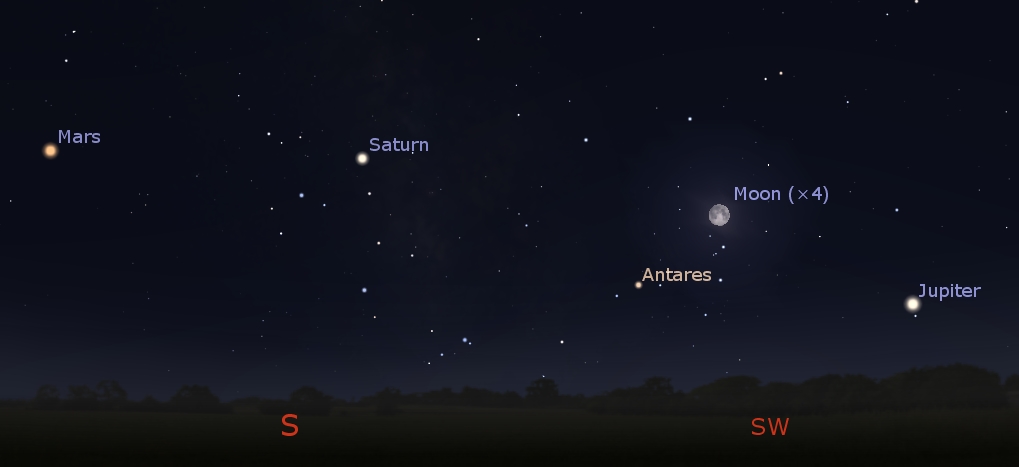 Planets in the southern sky at 4:00 AM, May 29, 2018. Credit: Stellarium / Bob Trembley.
Planets in the southern sky at 4:00 AM, May 29, 2018. Credit: Stellarium / Bob Trembley.Jupiter is in the southern sky after sunset, and is joined by the fun Moon on the 29th.
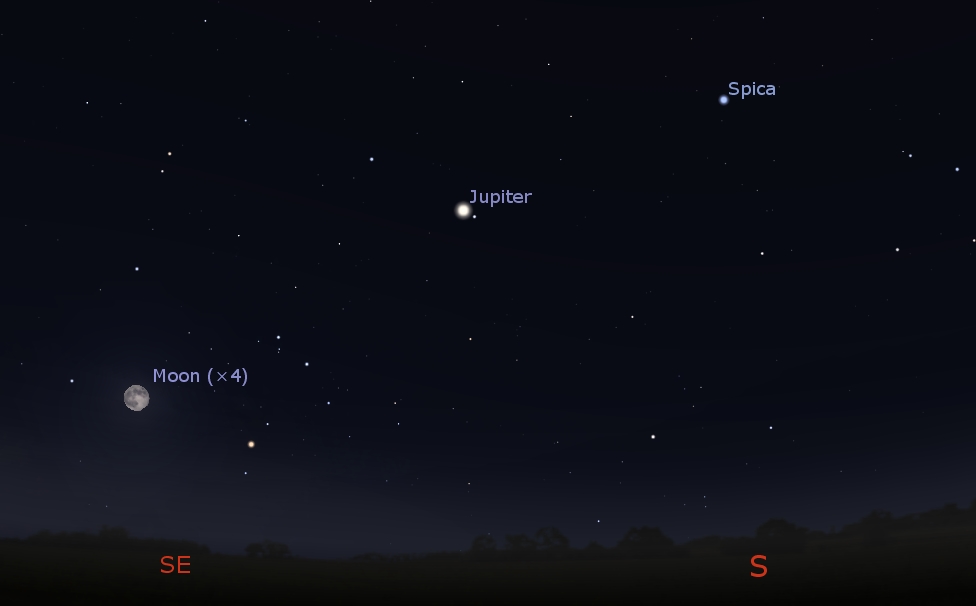 Jupiter in the southeastern sky with the Moon at 10:00 PM, May 29, 2018. Credit: Stellarium / Bob Trembley.
Jupiter in the southeastern sky with the Moon at 10:00 PM, May 29, 2018. Credit: Stellarium / Bob Trembley.The Moon
The Moon is full on the 29th, and visible all night long. The Moon will be a waning gibbous the remainder of the week rising later in the evening, and visible longer into the mornings. The Moon will be in conjunction with Saturn on June 1st, and Mars on June 3rd.
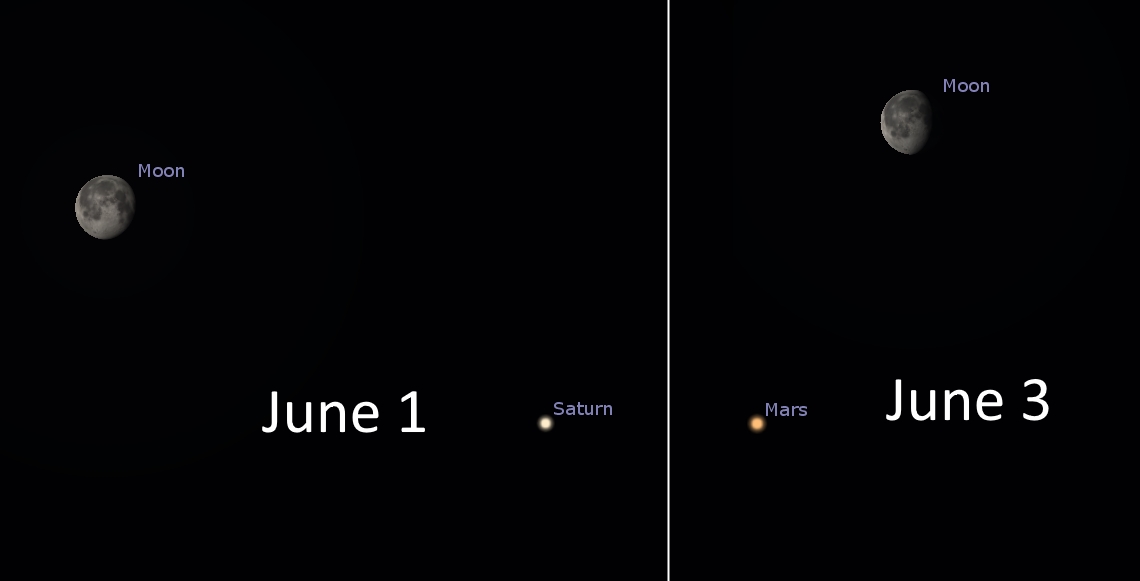 Moon in conjunction with Saturn and Mars – June 1 and 3, 2018. Credit: Stellarium/ Bob Trembley
Moon in conjunction with Saturn and Mars – June 1 and 3, 2018. Credit: Stellarium/ Bob TrembleyThe Sun
There are two sunspots this week: Active Region AR2710 is rotating out of view, and AR2712 rotated into view on May 24th and has made its way almost half-way across the face of the Sun.
AR2712 has a lot of coronal loop activity; SpaceWeather.com says: “Sunspot AR2712 is quiet, but it might not remain so. The sunspot has quadrupled in size in the past 48 hours. Instabilities in its fast-changing magnetic field could lead to solar flares.” Coronal holes continue to remain at both poles, and a rather large equatorial hole is rotating to point right at us! SpaceWeather.com again: “A solar wind stream is heading for Earth, flowing from an equatorial hole in the sun’s atmosphere. Estimated time of arrival: June 1st. G1-class geomagnetic storms and high-latitude auroras are possible when the gaseous material arrives.”
The solar wind speed is 415.0 km/sec, with a density of 7.0 protons/cm3.
Lots of short-lived pillar prominences have been popping up all over the Sun, and a “hedgerow prominence” has remained on the limb of the Sun over the last few days (lower left of the movie).
You can create your own time-lapse movies of the Sun here: AIA/HMI Browse Data.
You can browse all the SDO images of the Sun from 2010 to the present here: Browse SDO archive.
Asteroids
Upcoming Earth-asteroid encounters:
On May 26th, we had a close-shave with an asteroid passing within 0.8 lunar diameters.
| Asteroid |
Date(UT)
|
Miss Distance
|
Velocity (km/s)
|
Diameter (m)
|
| 2018 KY2 |
2018-May-26
|
0.8 LD
|
12.2
|
13
|
| 2018 JK3 |
2018-May-27
|
19.7 LD
|
21.8
|
165
|
| 2018 KR |
2018-May-28
|
15.7 LD
|
4
|
19
|
| 68347 |
2018-May-29
|
9.5 LD
|
13.3
|
389
|
| 2018 KN2 |
2018-May-29
|
6.1 LD
|
8
|
28
|
| 2013 LE7 |
2018-May-31
|
17.8 LD
|
1.7
|
12
|
| 2018 KE1 |
2018-Jun-01
|
10.8 LD
|
16.2
|
33
|
| 2018 EJ4 |
2018-Jun-10
|
5.6 LD
|
6.2
|
195
|
| 2015 DP155 |
2018-Jun-11
|
9 LD
|
4.4
|
170
|
| 2017 YE5 |
2018-Jun-21
|
15.6 LD
|
15.5
|
513
|
| 467309 |
2018-Jun-23
|
17.9 LD
|
14
|
355
|
| 441987 |
2018-Jun-24
|
7.3 LD
|
12.6
|
178
|
Notes: LD means “Lunar Distance.” 1 LD = 384,401 km, the distance between Earth and the Moon. Table from SpaceWeather.com
Near-Earth objects (NEOs) discovered this month: 115, this year: 749, all time: 18302.
Potentially hazardous asteroids: 1912 (as of May 29, 2018)
Minor Planets discovered: 774,880 (as of May 29, 2018)
Fireballs
On May 28, 2018, the NASA All Sky Fireball Network reported 10 fireballs.
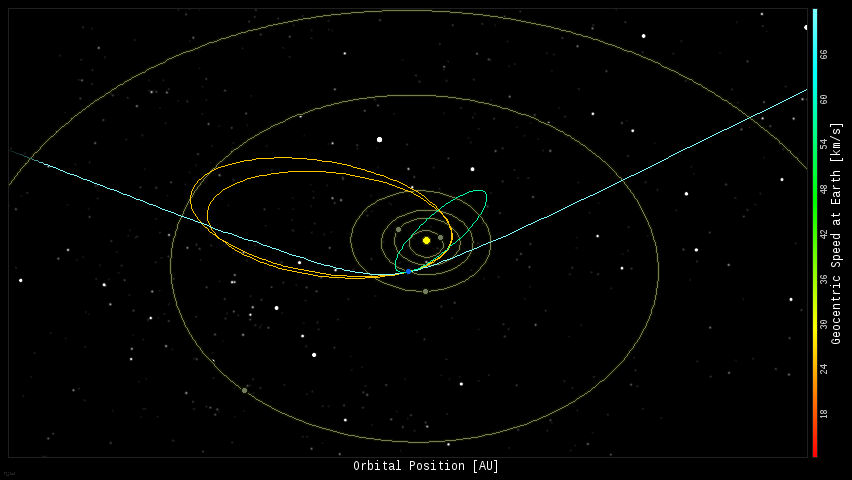 In this diagram of the inner solar system, all of the fireball orbits intersect at a single point–Earth. Source: Spaceweather.com
In this diagram of the inner solar system, all of the fireball orbits intersect at a single point–Earth. Source: Spaceweather.comThe Solar System
This is the position of the planets in the solar system:
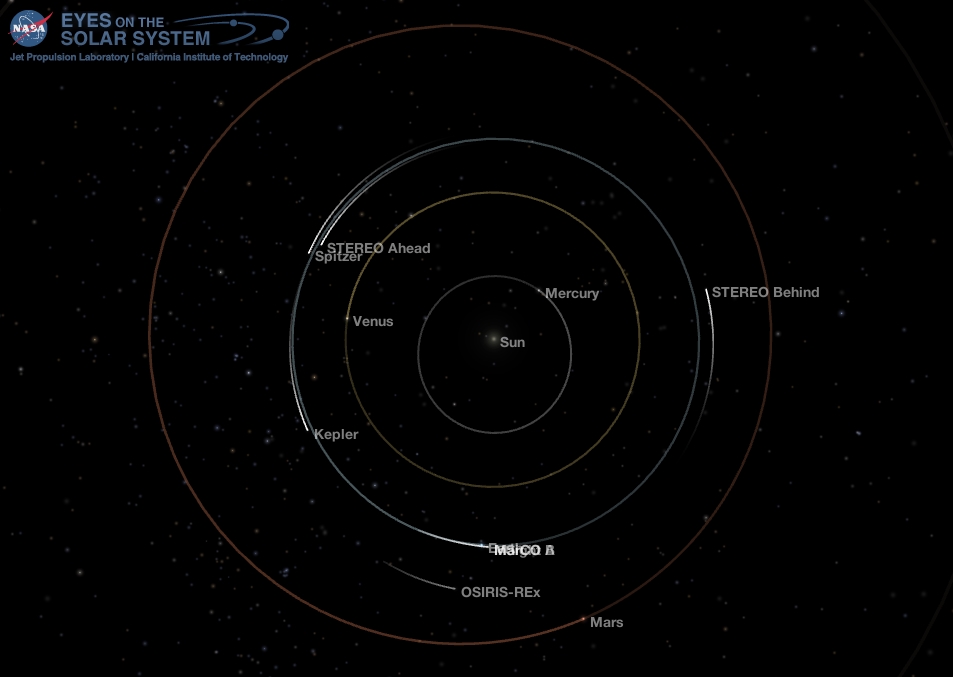 Position of the planets in the inner solar system, May. 29, 2018. Credit: NASA Eyes on the Solar System / Bob Trembley.
Position of the planets in the inner solar system, May. 29, 2018. Credit: NASA Eyes on the Solar System / Bob Trembley.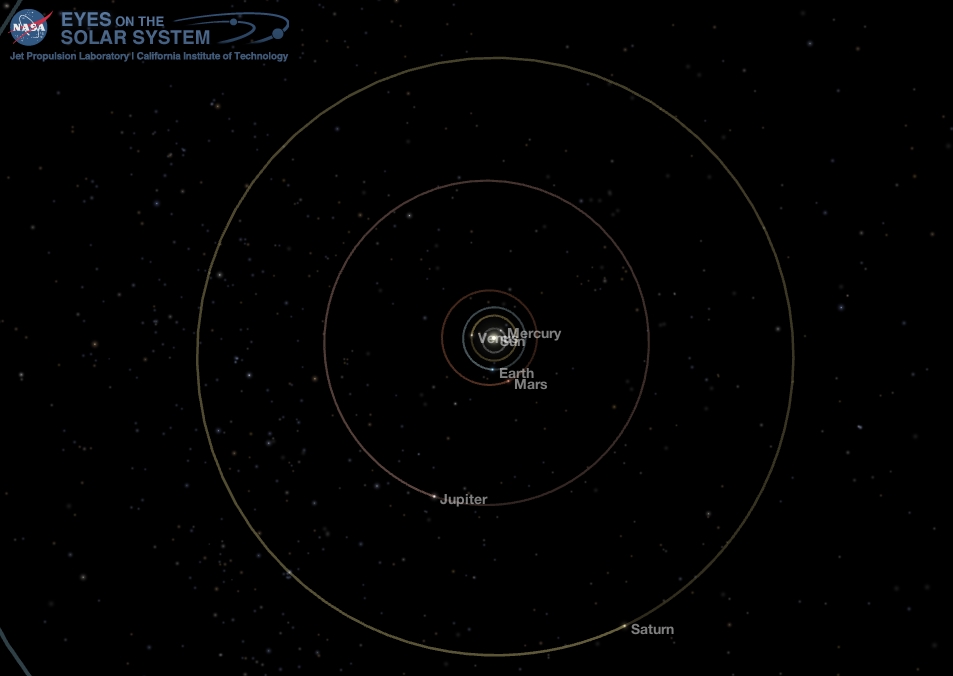 Position of the planets in the middle solar system, May. 29, 2018. Credit: NASA Eyes on the Solar System / Bob Trembley.
Position of the planets in the middle solar system, May. 29, 2018. Credit: NASA Eyes on the Solar System / Bob Trembley.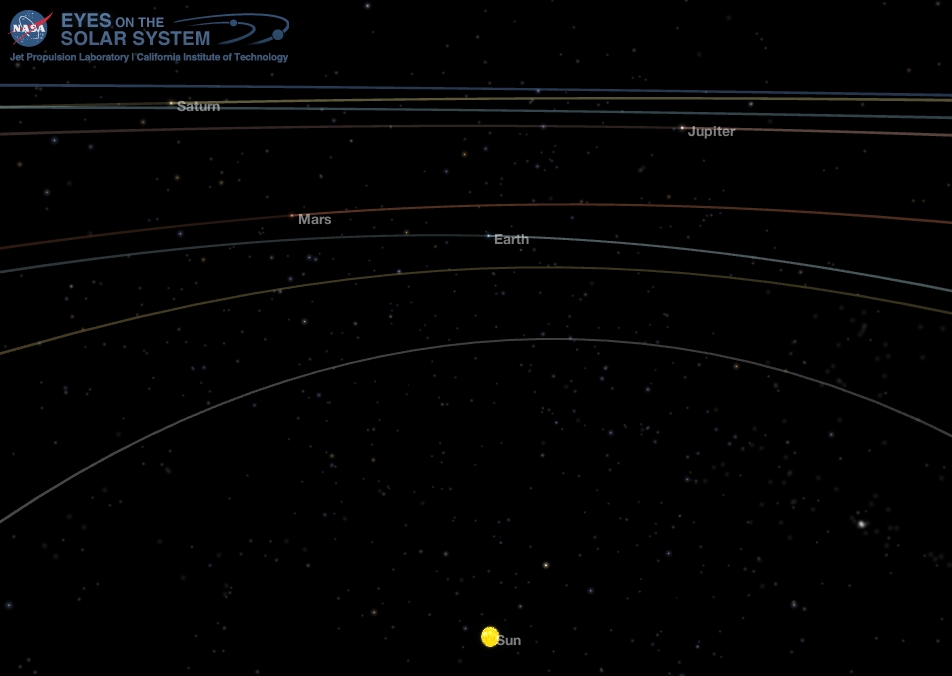 Solar System from behind the Sun looking towards Earth May 29 2018. Credit: NASA Eyes on the Solar System / Bob Trembley.
Solar System from behind the Sun looking towards Earth May 29 2018. Credit: NASA Eyes on the Solar System / Bob Trembley.Space Missions
The Insight, MarCOs and OSIRIS-Rex spacecraft are all “relatively close” to Earth, heading towards their destinations.
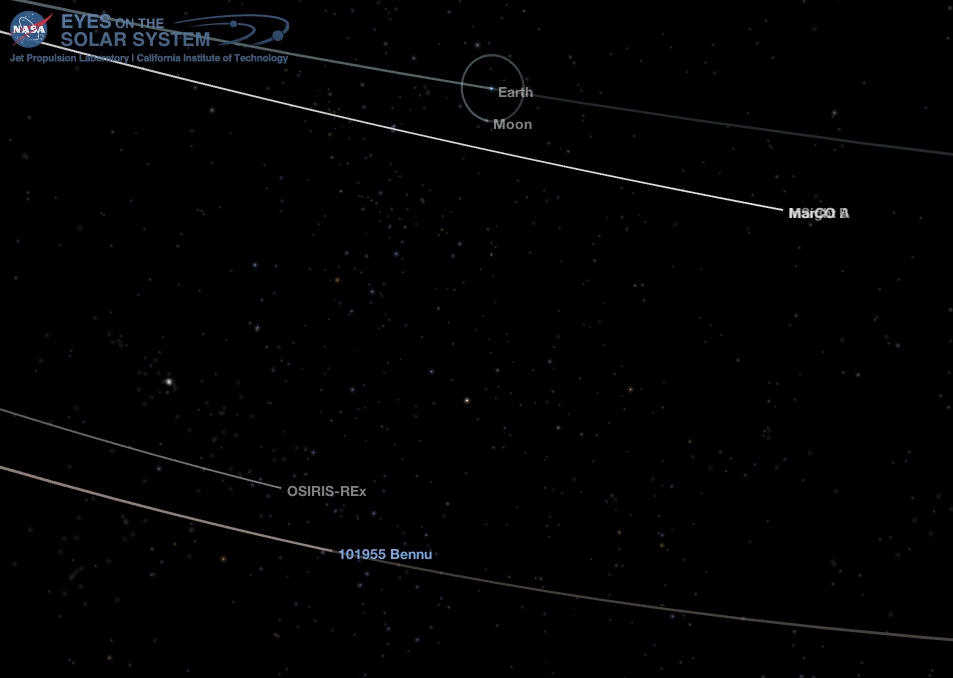 Interplanetary Spacecraft Near Earth, May. 29, 2018. Credit: NASA Eyes on the Solar System / Bob Trembley.
Interplanetary Spacecraft Near Earth, May. 29, 2018. Credit: NASA Eyes on the Solar System / Bob Trembley.Exoplanets
Confirmed Exoplanets: 3,730 (5/24/2018)
Multi-Planet Systems: 613 (5/24/2018)
Kepler Candidate Exoplanets: 4,496 (8/31/2017)
TESS Candidate Exoplanets: 0
Data from the NASA Exoplanet Archive
Apps used for this post:
Stellarium: a free open source planetarium app for PC/MAC/Linux. It’s a great tool for planning observing sessions.
NASA Eyes on the Solar System: an immersive 3D solar system and space mission simulator – free for the PC /MAC. I maintain the unofficial NASA Eyes Facebook page.


